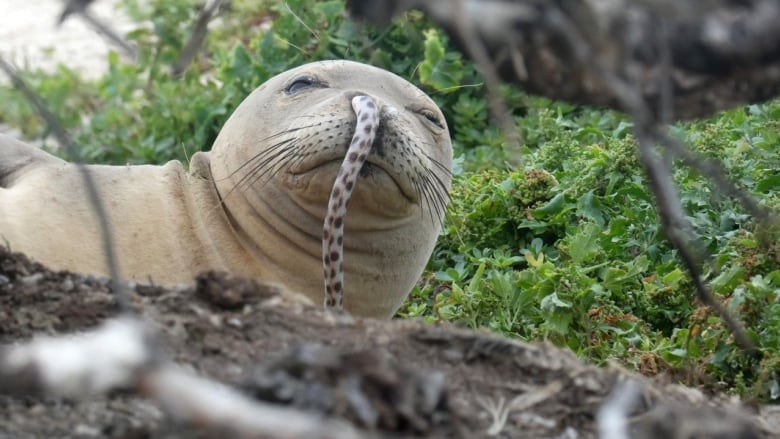Researchers don't know why seals are getting eels stuck in their noses
'We aren't entirely sure what is happening in this photo,' says marine veterinarian Michelle Barbieri

A viral photo of a Hawaiian monk seal with an eel dangling out of its nostril is just one of four such incidents recorded by the National Oceanic and Atmospheric Administration over the last two years.
Hawaii-based researchers who study the creatures don't know what's behind the bizarre phenomenon.
"We aren't entirely sure what is happening in this photo because the eel is dead and the seal seems to be doing OK," Michelle Barbieri, a veterinarian for NOAA's Hawaiian Monk Seal Research Program, told As It Happens host Carol Off.
"We're certainly curious to know a little bit more about what might be leading to these events."
- AS IT HAPPENS: Why a fishmonger bought a giant octopus, only to release it into the ocean
- AS IT HAPPENS: Why Trevor the wiener dog blew up like a 'really, really large balloon'
This particular seal was discovered in March of this year at French Frigate Shoals, an atoll off the northwest coast of Hawaii.
Precautionary eel extraction
Even though the creature didn't appear to be in distress, they decided to perform an eel extraction "out of an abundance of caution."
"It was not something we had a protocol for ahead of time," Barbieri said.
"We ended up deciding that the best thing was to slowly remove the eel. We didn't want it to break off and remain in the seal's nose, so it was pulled out very gently, very slowly. [It] took about minute to do."
Barbieri said the seal is alive and well, but "didn't appreciate being restrained."
The researchers have a couple of theories about how the eels end up in the nostrils of the seals.
It's possible, Barbieri said, that the seal gobbled up the eel, which is part of its natural diet, then snorted it out through its nose — like when you laugh while drinking.
"Why we haven't seen that before, if we know that eels are part of seal diets, might beg the question: Are there perhaps more eels around for the seals to be preying on?" she said.
"And, of course, that begs the question: What else is going on in the ecosystem that might be changing that food web?"
The other possibility is that the eel "deliberately crawled in the seal's nose."
But given the fact that seals' nostrils close when they are underwater, she said that one's a bit of a stretch.
"It's not impossible, but probably less likely than the regurgitation idea," Barbieri said.
Seals facing threats
But the monk seals face much greater threats than slippery eels.
Food scarcity, ocean debris, disease and other factors are all "chipping away" at the Hawaiian monk seal population, Barbieri said.
Hawaiian monk seals are listed as an endangered species in the U.S.
- AS IT HAPPENS: Orca mother holds calf afloat in apparent mourning ritual
- AS IT HAPPENS: One small nation's fight against climate change
"Eels — pretty funny to see popping up on Facebook. But there are really are some serious threats to the species and some of those do disproportionately impact young seals," Barbieri said.
"So we are really focused on running a conservation program that will help us recover this species."
Written by Sheena Goodyear. Produced by Katie Geleff.